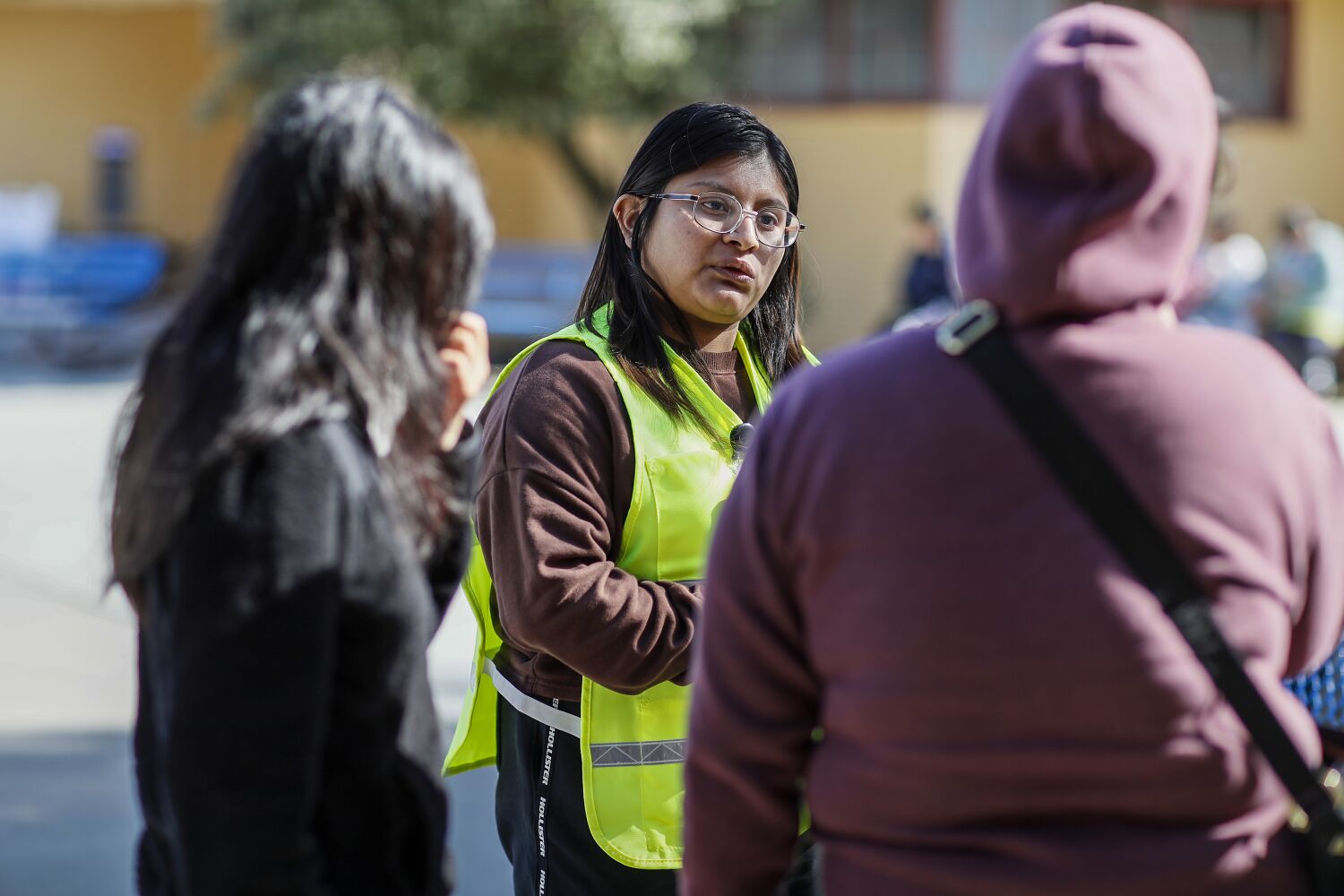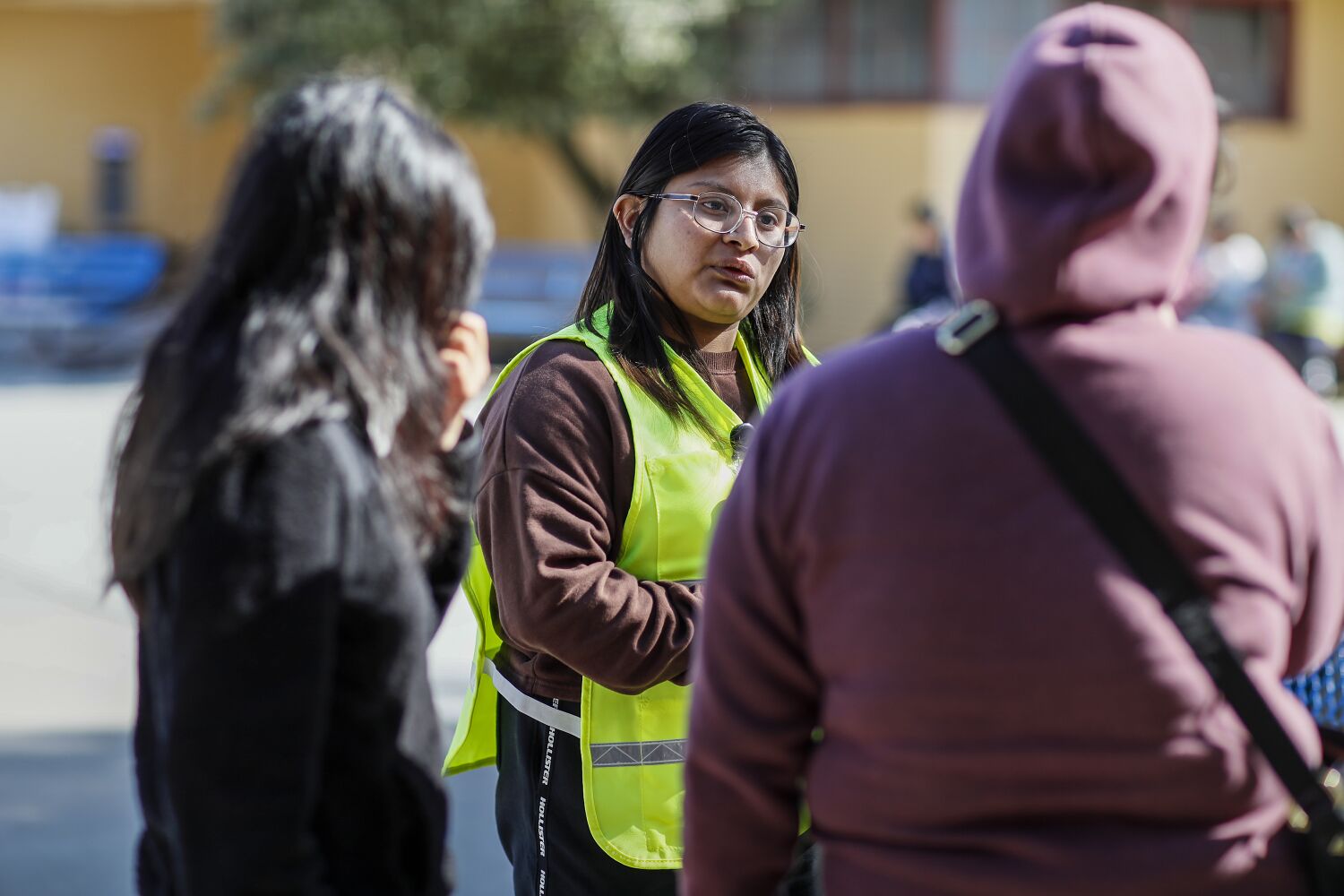
[ad_1]

Inside an evacuation heart on the Santa Cruz County Fairgrounds, Maria Adolfo-Morales and a catastrophe service volunteer listened to a girl describe her issues within the Mixteco language.
The lady and her three kids had been staying on the heart for every week, after a damaged levee flooded the farming city of Pajaro and compelled residents to flee.
Adolfo-Morales, a 22-year-old neighborhood healthcare employee, interpreted what the lady mentioned into English, then rendered the volunteer’s responses into Mixteco, one among a number of Indigenous languages spoken in southern Mexico.
The lady’s inquiries echoed these of different displaced residents: How do I apply for meals help? How do I apply for monetary help?
A lot of Pajaro’s agricultural employees are Mixteco audio system who will not be fluent in English or Spanish. Adolfo-Morales and different interpreters have been a lifeline for them as they determine the best way to survive after dropping their properties and livelihoods.
An estimated 170,000 Indigenous Mexican farmworkers reside in California, contributing to its booming financial system. That quantity doesn't take into consideration non-agricultural jobs, nor does it embody Indigenous immigrants from Guatemala, Nicaragua, Ecuador and Peru. Researchers say 6 in 10 farmworkers within the state are Indigenous.
Regardless of earlier disasters — the Thomas fireplace, the COVID-19 pandemic — state and native officers have but to completely embody this rising inhabitants into their planning, usually counting on nonprofits to speak fundamental info.
With completely different languages within the combine, and local weather change prone to spur extra excessive climate, neighborhood organizers say extra must be performed.
And now, every week after many Pajaro residents have gone dwelling, they might want to navigate difficult bureaucracies to get the assistance they should rebuild their lives, which might be monumentally troublesome even for English and Spanish audio system.
“The language barrier, coupled with the financial scenario that they’re in, you’ve bought lots of people attempting to course of and make sense of what has occurred and is occurring to them,” mentioned Erica Padilla-Chavez, government director of the Second Harvest Meals Financial institution Santa Cruz, which was among the many nonprofits offering language help on the fairgrounds shelter.
When evacuations started in Pajaro on March 10, a coalition of grassroots organizations, well-prepped by the pandemic, got here collectively to assist Indigenous farmworkers, mentioned MariaElena De La Garza, government director of the Neighborhood Motion Board of Santa Cruz County.
De La Garza mentioned her group and others, together with the meals financial institution, created a rotation of workers, contractors and volunteers who converse Mixteco, Triqui and Zapoteco, in addition to Spanish, on four- to five-hour shifts on the fairgrounds shelter, which housed greater than 300 evacuees.
Due to variations inside every Indigenous language, De La Garza additionally recruited residents and employees from the neighborhood to assist interpret.
Arcenio López, government director of Mixteco/Indigena Neighborhood Organizing Mission, mentioned there are greater than a dozen variants of the Mixteco language in Pajaro. Most residents, he mentioned, are from Oaxaca and Guerrero.
Mixteco can be spoken within the states of Michoacán and Puebla.
After the levee broke, neighborhood organizers labored with Monterey County officers to supply dozens of interpreters and volunteers to help households at native shelters and evacuation facilities.
“To have Indigenous interpreters on the fairgrounds as a precedence, that's new for us,” De La Garza mentioned. “We’ve discovered via the pandemic the significance of making certain that the techniques which might be set as much as be responsive are capable of attain the communities which might be most impacted.”
Luis Alejo, chair of the Monterey County Board of Supervisors, mentioned the county plans to make Indigenous interpreters an integral a part of the companies it gives to residents, finally together with courtrooms and the police and fireplace departments.
“This must be a part of how we ship emergency companies,” he mentioned. “We have to broaden that to different companies that the county gives too.”
On Adolfo-Morales’ first day on the evacuation heart, she defined to Maria Lopez the best way to get meals, clothes and monetary help.
Till then, Lopez had relied on her three sons to inform her what officers had been saying. Her sons converse Spanish and little English, making communication much more troublesome.
Lopez, 54, mentioned she was confused concerning the evacuation orders. She felt unhappy and pissed off not with the ability to perceive fireplace and police officers or ask questions.
“My kids would solely inform me we wanted to depart our dwelling,” Lopez mentioned in Mixteco whereas Adolfo-Morales interpreted.
Lopez puzzled what she would face when she returned dwelling. That they had left with solely the garments on their backs. She and her husband nervous about not having work within the strawberry fields, which had been flooded, and never with the ability to pay their $2,500 month-to-month hire and different payments.
Lopez was one among three Mixteco audio system Adolfo-Morales helped that Thursday afternoon. She mentioned that generally her skill to speak was restricted by the range of Indigenous languages — there are dozens of variations of Mixteco, usually revolving round individuals’s hometowns. At instances, she struggles to interpret English phrases that don’t exist in Mixteco, comparable to medical and authorized jargon.
Adolfo-Morales grew up deciphering and translating for her household. However in school, some college students taunted her in Spanish, calling her “little Oaxacan lady” and stringing gibberish phrases collectively in a Mixteco accent, she mentioned.
“It was offensive to me, however I’ve discovered to embrace and love my tradition now,” she mentioned
When she discovered concerning the L.A. Metropolis Corridor audio leak scandal and what a council member mentioned about Oaxacans, she felt disenchanted and remembered the bullying she skilled in class.
Dori Rose Inda, chief government of Salud Para La Gente, mentioned the pool of Indigenous translators has modified over the previous couple of many years.
Earlier than, many bilingual individuals lacked authorized standing and couldn’t be employed.
Now, as the youngsters of Indigenous farmworkers turn out to be adults, it’s not unusual to fulfill younger individuals of their 20s like Adolfo-Morales who converse English, Spanish and Mixteco.
“I’m assembly younger individuals who converse three languages,” she mentioned. “It can't occur quick sufficient.”
Amongst them is 21-year-old Edward Salvador, who was born in Watsonville and in addition volunteered on the fairgrounds. He mentioned that evacuees had been usually shocked once they requested him questions and he responded of their language.
“I’m positive it’s a aid for them to have the ability to talk their wants of their language,” he mentioned.
Like Adolfo-Morales, Salvador interpreted for his mother and father at physician’s appointments and crammed out types for them that had been offered solely in English or Spanish. After experiencing firsthand the dearth of sources accessible to households like his, Salvador determined to turn out to be a licensed interpreter.
On the fairgrounds, Maria Martinez wore the intense yellow vest that marked her as an interpreter. Above “Maria M.,” her identify tag learn “Mixteco interpreter” in English.
After three days, Martinez mentioned that individuals acknowledged her and approached her to ask for assist in Mixteco.
As an interpreter for the Pajaro Valley Unified Faculty District, Martinez was there to assist households with paperwork associated to highschool enrollment.
However usually, she was flagged down by individuals who wanted assist with meals, laundry and the shelter’s on-site clinic.
“A whole lot of the households right here want assist,” she mentioned.
Neighborhood organizers are pissed off that native governments haven't performed extra to deal with the language wants within the Central Valley. Nonetheless, they are saying some progress has been made.
They cite the interpreters on the fairgrounds, in addition to televised information conferences wherein Monterey County officers offered emergency response info in English, Spanish and Mixteco.
Leonor Mendoza was the Mixteco interpreter at one of many information conferences. It was essential for the Mixteco neighborhood to obtain important info — and listening to their native tongue in an official setting made them really feel seen, she mentioned.
Nonetheless, she nervous that different languages weren't included.
“We must always have performed it in a number of [Indigenous] languages in order to not depart others out,” Mendoza mentioned. “So, I felt just a little bit pissed off, however I additionally advised myself this was a step in the correct path. We’ve bought a foot within the door, and this was a superb factor.”
Mendoza had grown up with out studying Mixteco — her mother and father determined to not train her as a result of they feared discrimination, which is widespread in opposition to Indigenous individuals each in Mexico and the U.S.
Then, at 9, she returned to San Martín Peras, Oaxaca, unable to talk to any kinfolk besides her grandfather, who knew Spanish. She finally picked up Mixteco from him.
At 13, she migrated to the U.S. along with her mother and father, chasing strawberry work between Oxnard and Salinas. By then, she was already deciphering for her mother and father, together with when her mom suffered a stroke whereas crossing the border.
When the pandemic hit, she volunteered to interpret for Indigenous households.
She mentioned individuals acknowledge her from the information convention: “You’re that girl from TV,” they are saying.
She hopes that they, and their kids, see her as a Mixtec girl who's proud to talk their language.
“I feel that second served a function: that households ought to maintain instructing their language to the subsequent technology for them to cross on,” she mentioned.
[ad_2]
Supply hyperlink
https://classifiedsmarketing.com/today-news/amid-flood-interpreters-a-lifeline-for-indigenous-farmworkers/?feed_id=109908&_unique_id=6424ddebb14cf

0 Comments